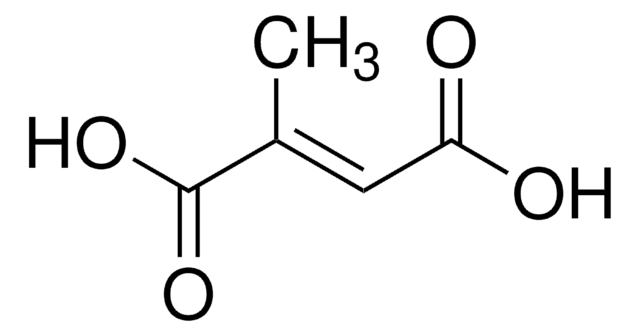49360
Glutaconic acid
97% (T)
Synonym(s):
2-Pentenedioic acid
Sign Into View Organizational & Contract Pricing
All Photos(1)
About This Item
Linear Formula:
HOOCCH2CH=CHCOOH
CAS Number:
Molecular Weight:
130.10
Beilstein:
1759560
EC Number:
MDL number:
UNSPSC Code:
12352100
PubChem Substance ID:
NACRES:
NA.22
Recommended Products
Assay
97% (T)
SMILES string
OC(=O)C\C=C\C(O)=O
InChI
1S/C5H6O4/c6-4(7)2-1-3-5(8)9/h1-2H,3H2,(H,6,7)(H,8,9)/b2-1+
InChI key
XVOUMQNXTGKGMA-OWOJBTEDSA-N
Looking for similar products? Visit Product Comparison Guide
Related Categories
General description
Glutaconic acid, also known as 2-pentenedioic acid, is an unsaturated dicarboxylic acid. It is formed as one of the degradation products during the partial wet oxidation (PWO) of alkali lignin. The analysis of its crystal structure indicates that the compound exists predominantly in the trans-conformation. The geometric bond lengths and bond angles of glutaconic acid have been obtained using Hartree–Fock (HF), density functional calculations and IR spectral data.
Application
Glutaconic acid has been used in the preparation of CoA-substrate glutaconyl-CoA by reacting with acetyl-CoA. It may be used in the preparation of 6-chloro-2(2H)-pyranone by reacting with phosphorus pentachloride (PCl5).
Storage Class Code
11 - Combustible Solids
WGK
WGK 3
Flash Point(F)
Not applicable
Flash Point(C)
Not applicable
Personal Protective Equipment
dust mask type N95 (US), Eyeshields, Gloves
Certificates of Analysis (COA)
Search for Certificates of Analysis (COA) by entering the products Lot/Batch Number. Lot and Batch Numbers can be found on a product’s label following the words ‘Lot’ or ‘Batch’.
Already Own This Product?
Find documentation for the products that you have recently purchased in the Document Library.
Customers Also Viewed
Crystal and molecular structure of glutaconic acid.
Thomas L and Srikrishnan T.
Journal of Chemical Crystallography, 33(9), 689-693 (2003)
Alkaline Partial Wet Oxidation of Lignin for the Production of Carboxylic Acids.
Demesa AG, et al.
Chemical Engineering & Technology, 38(12), 2270-2278 (2015)
6-Chloro-2(2H)-pyranone: a new 2(2H)-pyranone synthon.
Biagetti M, et al.
Tetrahedron Letters, 44(3), 607-610 (2003)
Rui Pereira et al.
Metabolic engineering, 56, 130-141 (2019-09-25)
Improving the growth phenotypes of microbes in high product concentrations is an essential design objective in the development of robust cell factories. However, the limited knowledge regarding tolerance mechanisms makes rational design of such traits complicated. Here, adaptive laboratory evolution
W Buckel et al.
FEBS letters, 148(1), 35-38 (1982-11-01)
The decarboxylation of glutaconyl-CoA to crotonyl-CoA in the anaerobic bacterium Acidaminococcus fermentans is catalysed by a membrane-bound, biotin-dependent enzyme which requires Na+ for activity. Inverted vesicles from A. fermentans accumulated Na+ only if glutaconyl-CoA was decarboxylated. The Na+ uptake was
Our team of scientists has experience in all areas of research including Life Science, Material Science, Chemical Synthesis, Chromatography, Analytical and many others.
Contact Technical Service








